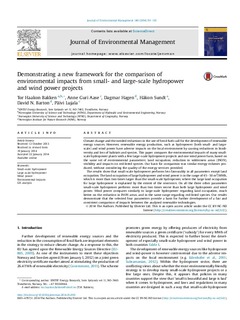| dc.contributor.author | Bakken, Tor Haakon | |
| dc.contributor.author | Aase, Anne Guri | |
| dc.contributor.author | Hagen, Dagmar | |
| dc.contributor.author | Sundt, Håkon | |
| dc.contributor.author | Barton, David Nicholas | |
| dc.contributor.author | Lujala, Paivi | |
| dc.date.accessioned | 2017-10-25T09:27:26Z | |
| dc.date.available | 2017-10-25T09:27:26Z | |
| dc.date.created | 2014-01-22T13:08:22Z | |
| dc.date.issued | 2014 | |
| dc.identifier.citation | Journal of Environmental Management. 2014, 140 93-101. | nb_NO |
| dc.identifier.issn | 0301-4797 | |
| dc.identifier.uri | http://hdl.handle.net/11250/2462043 | |
| dc.description.abstract | Climate change and the needed reductions in the use of fossil fuels call for the development of renewable energy sources. However, renewable energy production, such as hydropower (both small- and large-scale) and wind power have adverse impacts on the local environment by causing reductions in biodiversity and loss of habitats and species. This paper compares the environmental impacts of many small-scale hydropower plants with a few large-scale hydropower projects and one wind power farm, based on the same set of environmental parameters; land occupation, reduction in wilderness areas (INON), visibility and impacts on red-listed species. Our basis for comparison was similar energy volumes produced, without considering the quality of the energy services provided.
The results show that small-scale hydropower performs less favourably in all parameters except land occupation. The land occupation of large hydropower and wind power is in the range of 45–50 m2/MWh, which is more than two times larger than the small-scale hydropower, where the large land occupation for large hydropower is explained by the extent of the reservoirs. On all the three other parameters small-scale hydropower performs more than two times worse than both large hydropower and wind power. Wind power compares similarly to large-scale hydropower regarding land occupation, much better on the reduction in INON areas, and in the same range regarding red-listed species. Our results demonstrate that the selected four parameters provide a basis for further development of a fair and consistent comparison of impacts between the analysed renewable technologies. | nb_NO |
| dc.language.iso | eng | nb_NO |
| dc.publisher | Elsevier | nb_NO |
| dc.rights | Attribution-NonCommercial-NoDerivatives 4.0 Internasjonal | * |
| dc.rights.uri | http://creativecommons.org/licenses/by-nc-nd/4.0/deed.no | * |
| dc.title | Demonstrating a new framework for the comparison of environmental impacts from small- and large-scale hydropower and wind power projects | nb_NO |
| dc.type | Journal article | nb_NO |
| dc.type | Peer reviewed | nb_NO |
| dc.description.version | publishedVersion | nb_NO |
| dc.subject.nsi | VDP::Samfunnsgeografi: 290 | nb_NO |
| dc.subject.nsi | VDP::Human geography: 290 | nb_NO |
| dc.source.pagenumber | 93-101 | nb_NO |
| dc.source.volume | 140 | nb_NO |
| dc.source.journal | Journal of Environmental Management | nb_NO |
| dc.identifier.doi | 10.1016/j.jenvman.2014.01.050 | |
| dc.identifier.cristin | 1097304 | |
| dc.relation.project | Norges forskningsråd: 193818 | nb_NO |
| dc.relation.project | Norges forskningsråd: 215934 | nb_NO |
| dc.description.localcode | © 2014 The Authors. Published by Elsevier Ltd. This is an open access article under the CC BY-NC-ND license (http://creativecommons.org/licenses/by-nc-nd/3.0/) | nb_NO |
| cristin.unitcode | 194,64,91,0 | |
| cristin.unitcode | 194,67,10,0 | |
| cristin.unitname | Institutt for bygg- og miljøteknikk | |
| cristin.unitname | Institutt for geografi | |
| cristin.ispublished | true | |
| cristin.fulltext | original | |
| cristin.qualitycode | 1 | |

